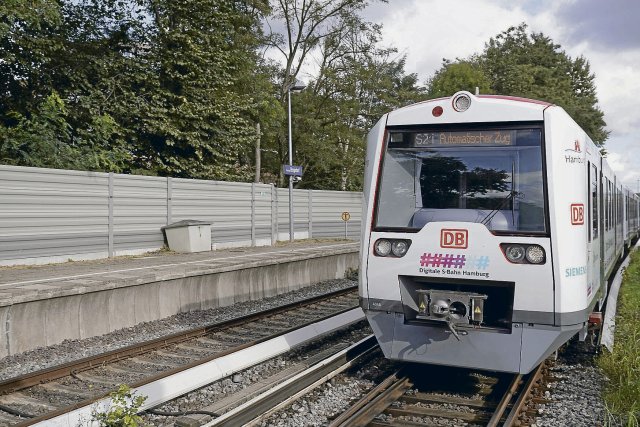Autonomous driving: trains and ships controlled as if by magic
[ad_1]
Shipmaster David Tangermann is still in control of the test freight ship, which steers independently through the Dortmund-Ems Canal thanks to radar, cameras, laser scanners and sensors.
Photo: dpa/Dieter Menne
With a bit of luck, a trip on the Hamburg S2 is a journey into the mobility of the future. Leaving the center we head east, first to Bergedorf, then on to Aumühle. The first highly automated S-Bahn trains in Germany run here. But technical progress is coming at a fairly quiet pace. “The automation is not necessarily noticeable for the normal passenger,” says Christoph Gonçalves Alpoim, head of the Digital S-Bahn Hamburg project. Because it doesn’t matter whether in automated driving or quite traditionally controlled by hand – on the way to the next station, the red-painted cars simply hum quietly to themselves.
However, automated trains are not as new as they seem. In Lille, northern France, the subways have been fully automated for around 40 years, and two subway lines in Nuremberg have also been running without drivers for many years. So why the excitement about the fully automated S-Bahn in Hamburg, where there is even a driver in the driver’s cab for safety? “Metro systems are mostly self-contained systems with an isolated infrastructure and isolated vehicles that run there,” explains Gonçalves Alpoim. The closed system, mostly in tunnels underground, reduces possible external influences and makes it comparatively easy to automate driving. “Railways, on the other hand, run in open systems that always keep trans-European traffic in mind,” says the digitalization expert. “So on every railway route there must be the possibility that freight trains or railways from other countries can also run on the same infrastructure.”
In fact, technical development for autonomous driving on railways is already well advanced. An important component is the “ATO over ETCS” application, which consists of two Europe-wide standardized systems: the European train control system ETCS and the automatic driving mode ATO. ETCS monitors the speed of trains and ensures that they can be stopped quickly and safely in an emergency. ATO takes care of the rest: starting, braking, opening and closing the doors – all automatically. Before its introduction in 2022, the Hamburg S-Bahn teamed up with the city to conduct a study to examine what advantages the new system would bring. The results convinced him: “We have 30 percent more capacity on the existing infrastructure and 40 percent fewer train delays,” says Gonçalves Alpoim. “That means I have more capacity, which I use not only to run more trains, but also to implement more stable rail operations.”
But: If the train driver only has to monitor the journey – why is there still a person in the driver’s cab? “For us, full automation is a leap too big,” says Gonçalves Alpoim. “In addition, it would take too long without us creating more capacity or reliability in rail operations.” The hurdles for so-called fully automated operation – i.e. driverless journeys – are very high in rail transport: On the one hand, you would need additional technology such as functioning obstacle detection on the route. On the other hand, unlike subways, fully automated rail operations in Germany are not yet permitted in regular operation. And it is not at all certain whether personnel could be saved at all if the S-Bahn were completely self-controlled. This is also shown by the experience with the fully automated subway in Nuremberg: the savings in train drivers are offset by more personnel costs in the control centers and in checking the stations.

In Hamburg, the S2 already runs in regular operation without a train driver.
Photo: imago images/cover images
That’s why Dirk Flege doesn’t see the train driver’s job threatened by fully automated driving in the foreseeable future. “Even if it is technically possible on the entire German rail network, we do not believe that it will be practiced in the next ten or 20 years because people have the need to be able to address staff in normal rail traffic,” says the railway’s managing director -Allianz pro-Rail lobby association. This particularly applies to long distances or journeys such as those with the ICE, where the presence of a train driver provides passengers with security. “We humans are wired in such a way that we tend to be more anxious at high speeds than would be appropriate based on the pure accident statistics,” says Flege. As early as 2018, a research project commissioned by the Federal Ministry of Transport came to the conclusion that social acceptance of driverless trains in high-speed transport is likely to be low; In addition, the savings potential from fewer train crews would be offset by a high level of additional technical effort.
Rail expert Flege still sees great opportunities for fully automated rail travel: “There are exciting pilot tests that show that even on closed routes in both directions, individual capsules can transport passengers as needed and required in rural regions, completely autonomously and without a driver,” says the rail expert . Flege is thinking of projects such as the Monocab, a self-propelled monorail that could bring disused tracks back to life and, after initial test runs, should be used in North Rhine-Westphalia in just a few years.
But the legal situation is complicated: fully automated and driverless driving is permitted in the tram construction and operating regulations – but the regulation only applies to closed systems such as subways that run on their own tracks. However, it is prohibited in the railway construction and operating regulations. There are many reasons for this: Railway routes are more complex, there is more to think about: different types of vehicles travel on the same route, long-distance and local trains as well as freight trains. This makes automation more difficult. In addition, in contrast to subways in tunnels, the routes are more susceptible to external influences such as fallen trees or storm damage to overhead lines.
Rupert Henn is also very familiar with concerns about the legal hurdles – after all, fully automated driving has not yet been permitted in regular operation in inland shipping. As with the railway, there has long been research into concepts that are intended to simplify the transport of people and goods, for example by remotely controlling ships. “Technically it works, but it is not yet possible in terms of approval,” says Henn, managing director of the development center for ship technology and transport systems in Duisburg.
Remote-controlled driving could be a remedy for the widespread shortage of skilled workers in inland shipping. “If you can move the job of shipmaster to land, it could increase its attractiveness and get young people more interested in the job,” believes Henn. After all, the job today involves long hours on board far from home – many potential young talents don’t feel like doing that. The idea of remote control seems like a good way out. But how do you steer a ship from your desk? »The control and transmission are internet-based; the skipper looks at the live streams from his camera and his radar images,” explains Henn. “He now has all the information he normally has on board at his workplace on land.”
But many questions still remain unanswered: What happens to the remote-controlled ship if the internet fails? Although the system uses various providers for Internet access, it is not yet prepared for a complete failure, says Henn. They are working on how the ship could be automatically brought into a safe condition. The tests in a pilot project on the Rhine with a large shipping company were certainly promising. “Shipmasters who already know the type of ship only need a few hours to familiarize themselves with the new system and then they will be able to control it,” says the engineer. »They would prefer to be on board and would like to feel the vibration of the ship because that’s what they’re used to. But they can also take control from land.”
The development towards fully automated driving on water is continuous – and actually quite unspectacular. “There are assistance systems that are already on board,” says Rupert Henn. This includes a type of autopilot or a collision warning system. “And if you combine these assistance systems, you essentially have a fully automated ship.” This could mean that inland waterway boatmen are allowed to work longer shifts than they do today. “You could imagine that a ship’s captain would then only be on board for monitoring purposes and the automation would take over the actual work of steering,” says Henn. The machine drives, the person monitors – after all, that is already the reality on many ships today.
Rupert Henn sounds a bit like Christoph Gonçalves Alpoim, the head of the digital S-Bahn Hamburg. Regardless of whether it is a train or an inland waterway vessel – even if automated driving is the future, humans are far from obsolete. “There will be ships that, for many reasons, still have staff on board – and there will be other ships that can be imagined as pure transport bodies that simply bring containers from A to B,” predicts Rupert Henn. “We’ll have mixed traffic for a long time, maybe even forever.”
Subscribe to the “nd”

Being left is complicated.
We keep track!
With our digital promotional subscription you can read all issues of »nd« digitally (nd.App or nd.Epaper) for little money at home or on the go.
Subscribe now!
[ad_2]
Source link



